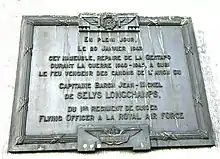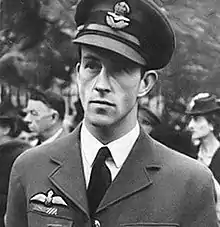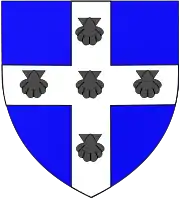Jean de Selys Longchamps
Baron Jean Michel P.M.G. de Selys Longchamps DFC (31 May 1912 – 16 August 1943) was a Belgian aristocrat and RAF fighter pilot during World War II who is chiefly notable for his solo 1943 attack on the Gestapo headquarters in Brussels in German-occupied Belgium.[1][2][3]

Jean de Selys Longchamps | |
|---|---|
 | |
| Born | 31 May 1912 Brussels, Belgium |
| Died | 16 August 1943 (aged 31) Manston, Kent, United Kingdom |
| Allegiance | |
| Belgian Army (until 1940) Royal Air Force (1940-1943) | |
| Rank | Captain (Belgian Army) Flying Officer (RAF) |
| Unit | No. 609 Squadron RAF |
| Battles/wars | Second World War |
| Awards | Distinguished Flying Cross Knight of the Order of Leopold (Posthumous)  Coat of arms of Selys Longchamps |
Military career

A Belgian cavalry officer with the 1er Régiment des Guides, he escaped with the BEF from Dunkirk returning to France before it finally fell. Trying to join the allies again he was interned by the Vichy authorities but escaped to Britain and was accepted for flight training with the RAF. He was posted to No. 609 Squadron RAF and flew Hawker Typhoons.
He is remembered for his unauthorised solo airstrike on the Gestapo headquarters located at 453 Avenue Louise[lower-alpha 1] in Brussels on 20 January 1943, which led to his demotion (to Pilot Officer) for acting without orders, but he was also awarded the Distinguished Flying Cross for his actions.[4][5] He also dropped a Belgian flag. After the attack, the Nazis admitted four fatalities and five serious injuries.[6] A bust commemorating Longchamps' actions now stands near the site.[7][8]
He was killed 16 August 1943 when his aircraft crashed on landing at RAF Manston after a sortie over Ostend.[1]
His body was buried in Minster-in-Thanet. A commemoration of his life was held on 16 August 2013 in conjunction with the Royal British Legion.[9][10]
References
- Notes
- The building is still standing and can be found at 50°49′4.37″N 4°22′15.63″E
- Citations
- Donnet 2007, p. 117
- "Baron Jean De Selys". home.clara.net.
- Weygantt, Kurt. "World War II Aces - Jean de Selys Longchamps". users.telenet.be.
- "F/Lt Baron Jean de Selys Longchamps' Attack on Gestapo HQ and a hectic day for No.609 Sqn – January 20 1943". History of Manston Airfield. Retrieved 7 May 2018.
- Donnet 2007, p. 128
- p. 3. Marion Schreiber. 2003. The Twentieth Train: The True Story of the Ambush of the Death Train to Auschwitz. (Translation by Shaun Schreiber from Stille Rebellen, 2000.) New York: Grove Press.
- "Baron Jean de Sélys-Longchamps". Memorials of Brussels. Retrieved 7 May 2018.
- p. 148e. Marion Schreiber. 2003. The Twentieth Train: The True Story of the Ambush of the Death Train to Auschwitz. (Translation by Shaun Schreiber from Stille Rebellen, 2000.) New York: Grove Press.
- "Service for RAF airman Baron Jean De Selys-Longchamps". BBC News. Retrieved 7 May 2018.
- Grave of Selys-Longchamps on the Findagrave website (2019). https://www.findagrave.com/memorial/47321760/jean-michel_paul_ghislain-de_selys_longchamps
- Bibliography
- Donnet, Mike (2007). Les aviateurs belges dans la Royal Air Force (in French). Bruxelles: Racine. ISBN 978-2-87386-472-9.CS1 maint: ref=harv (link)